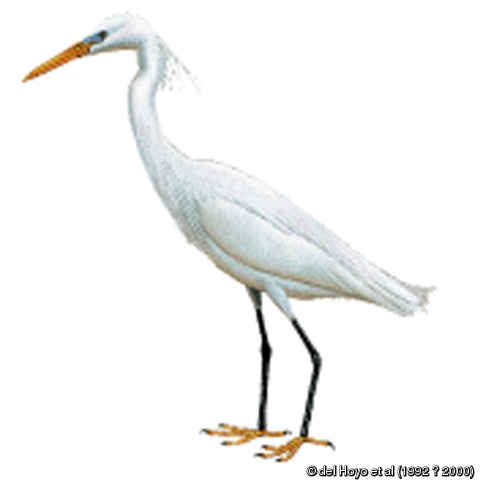| Citation |
|
Description |
Geographic Range [top]
Range Description: Egretta eulophotes breeds on small islands off the coasts of eastern Russia, North Korea, South Korea and mainland China. It formerly bred in Taiwan (China) and Hong Kong (China), but is now only a non-breeding visitor or passage migrant. It is also a non-breeding visitor to Japan, the Philippines, Vietnam, Thailand, Peninsular and eastern Malaysia (Sarawak), Singapore, Indonesia (Sumatra, Java, Kalimantan and Sulawesi) and Brunei. Key wintering areas are the Eastern Visayas (Leyte, Bohol and Cebu), Philippines, and the Malaysian states of Sarawak and Selangor where 30-50% of the global population are believed to winter based on winter counts in 2004/2005 (Li 2006). The population is estimated at 2,600-3,400 mature individuals. There has been no significant decline in this species in the last ten years (Simba Chan in litt. 2002), and recent discoveries of new colonies off southern China may represent increased observer effort, but possibly indicate some improvement in the speciess status.
Countries occurrence:
Native
Brunei Darussalam; China; Hong Kong; Indonesia; Japan; Korea, Democratic Peoples Republic of; Korea, Republic of; Malaysia; Philippines; Russian Federation; Singapore; Taiwan, Province of China; Thailand; Viet Nam
Vagrant:
United States
Present - origin uncertain:
Macao
Additional data:
? Continuing decline in area of occupancy (AOO): Unknown
? Extreme fluctuations in area of occupancy (AOO): No ? Estimated extent of occurrence (EOO) - km2: 1240000
? Continuing decline in extent of occurrence (EOO): Unknown ? Extreme fluctuations in extent of occurrence (EOO): No
? Number of Locations: 11-100 ? Continuing decline in number of locations: Unknown
? Extreme fluctuations in the number of locations: No
Range Map: Click here to open the map viewer and explore range.
Population [top]
Population: The global population was estimated to number c.2,600-3,400 individuals, roughly equivalent to 1,700-2,300 mature individuals, based on records and surveys (BirdLife International 2001). However, this is thought to be an underestimate, as the number in China alone is estimated at c.1,000 mature individuals and could be around 1,500-2,000 mature individuals (Xiaolin Chen et al. in litt. 2012). On this basis, the population is placed in the band for 2,500-9,999 mature individuals, which is probably equivalent to 3,800-15,000 individuals, assuming that mature individuals account for around 2/3 of the population.
Trend Justification: Surveys of a breeding population on an offshore island in southern China indicate a decline of 22% over six years (Xiaolin Chen et al. in litt. 2012). There is little additional evidence for a significant decline in this speciess population over the last ten years, although overall some decline (<20% over ten years) is suspected to be occurring, owing to on-going loss and degradation of available habitat through reclamation, especially of offshore breeding islands.
Current Population Trend: Decreasing
Additional data:
? Number of mature individuals: 2500-9999 ? Continuing decline of mature individuals: Yes
? Extreme fluctuations: No ? Population severely fragmented: No
? No. of subpopulations: 2-100 ? Continuing decline in subpopulations: Unknown
? Extreme fluctuations in subpopulations: No ? All individuals in one subpopulation: No
Habitat and Ecology [top]
Habitat and Ecology: It occurs in shallow tidal estuaries, mudflats and bays, occasionally visiting fishponds and paddy-fields. Since 1985, all breeding records have been from uninhabited offshore islands.
Systems: Terrestrial; Freshwater; Marine
Continuing decline in area, extent and/or quality of habitat: Unknown
Generation Length (years): 6.6
Movement patterns: Full Migrant
Congregatory: Congregatory (and dispersive)
Threats [top]
Major Threat(s): By the end of the 19th century, it had been almost totally extirpated by persecution motivated by factors including the trade in its plumes. Today, the greatest threat is habitat loss and degradation through reclamation of tidal flats, estuarine habitats and uninhabited offshore breeding islands for infrastructure, industry, aquaculture and agriculture, and through pollution. Fishers in Liaoning, China, collect eggs for food, and breeding birds are threatened by disturbance. The rapid decline of a colony at Shin-do, South Korea, in the early 1990s, was apparently a result of disturbance by photographers. Has been documented as being hunted by poachers 2009-2012, though only one individual was recorded (MaMing et al. 2012).
Conservation Actions [top]
Conservation Actions: Conservation Actions Underway
CMS Appendix I. It is legally protected in Russia, China (including Hong Kong), Taiwan, and South Korea. Some important breeding, staging and wintering sites are protected, including the Far Eastern Marine Reserve (Russia) and sites in China, including Hong Kong, Taiwan, North Korea, South Korea, Vietnam and the Philippines.
Conservation Actions Proposed
Survey the coast of China, North Korea and South Korea for breeding sites and monitor existing sites. Survey its wintering range for new sites and establish a winter monitoring programme. Create a network of environmentally stable sites for it in the central Philippines. Extend the boundaries of the Far Eastern Marine Reserve to include the coast between the Tumen river mouth and Posyet Bay (Russia). Establish as protected areas Thai Thuy in the Red River delta and Bai Boi in the Mekong delta (Vietnam). Incorporate mudflats and mangroves near Krabi within the Hat Nopparat Tara National Park (Thailand). Establish protected areas at Pulau Bruit, Sarawak (Malaysia). Protect offshore breeding islands in China and North Korea. Prohibit egg-collecting in the breeding grounds in China and North Korea.
Citation: BirdLife International. 2016. Egretta eulophotes. The IUCN Red List of Threatened Species 2016: e.T22696977A93596047. http://dx.doi.org/10.2305/IUCN.UK.2016-3.RLTS.T22696977A93596047.en. Downloaded on 12 April 2017.
Disclaimer: To make use of this information, please check the .
Feedback: If you see any errors or have any questions or suggestions on what is shown on this page, please provide us with feedback so that we can correct or extend the information provided
|


